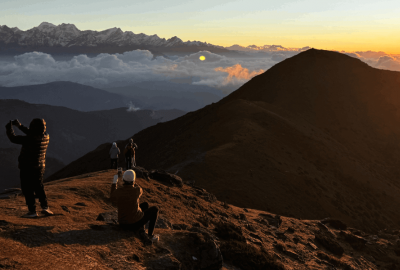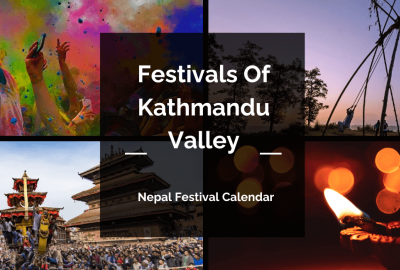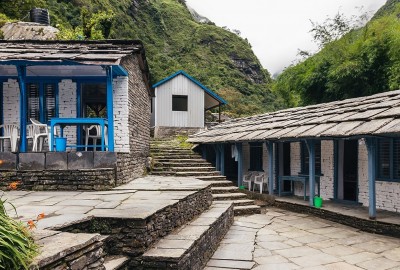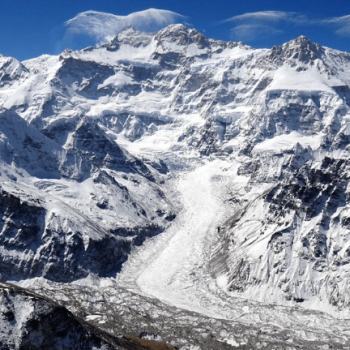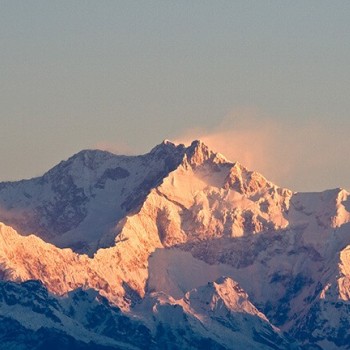Trekkers who enjoy isolation will find the Kanchenjunga Base Camp Trek an excellent opportunity to visit the base camp of the third-tallest peak in the world. Mt. Kanchenjunga, one of the world's most stunning peak massifs, is situated in the far northeastern region of Nepal. "Five Treasures of the Great Snow" is how the five summits that makeup Kanchenjunga are referred to in the name. We also gain a unique perspective on the rural Nepalese living in the eastern part of the country by making the lengthy trek on a less traveled trail.
Table of Contents
Plan your trip to Nepal
Customize your trip with help from a local travel specialist.
Trek Highlights
- Duration: Typically 19 to 26 days depending on the specific itinerary and pace.
- Maximum Altitude: Approximately 5,143 meters (16,873 feet) at the Pangpema viewpoint.
- Difficulty Level: Strenuous, requiring good physical fitness and prior trekking experience.
- Best Seasons: March to May and September to November, when the weather is stable and the views are clear
Kanchenjunga Trek Iitnerary
DAY 1: Arrival in Kathmandu
Welcome to Nepal, the land of Himalayan paradise! Upon your arrival, a guide from Mount Mania will greet you and transport you to your hotel. After settling in, take the opportunity to explore bustling Kathmandu, including areas like Thamel, Durbar Marg, and Ason Bazaar, or simply rest after your journey. You will be staying overnight in Kathmandu.
DAY 2: Kathmandu Sightseeing and Trek Preparation
Begin your day with a cultural exploration of Kathmandu after breakfast. Visit UNESCO World Heritage sites such as Kathmandu Durbar Square, Pashupatinath temple, Boudhanath stupa, and Swayambhunath temple. Later, your trek guide will provide a briefing on the upcoming adventure, allowing time for preparations. You will be staying overnight in Kathmandu.
DAY 3: Flight to Bhadrapur and Drive to Mitlung
Commence your journey to the Kanchenjunga trek with a morning flight to Bhadrapur, followed by a scenic drive to Mitlung. En route, soak in the picturesque views of green hills and rural landscapes. Mitlung serves as the starting point for your trekking adventure. You will be staying overnight in Mitlung.
DAY 4: Trek from Mitlung to Chiruwa
Embark on your trek along the Kanchenjunga circuit trail. Trek through dense sub-tropical rainforests, passing through Sinwa, Tawa, and Thiwa, until you reach the small Limbu settlement of Chiruwa. You will be staying overnight in Chiruwa.
DAY 5: Trek from Chiruwa to Sukethum
Set out early from Chiruwa and trek through Taplethok, Sagu, Madibun, and Phembu before reaching Sukethum. Along the way, enjoy the scenic beauty of the Tamor Nadi riverside and the Simbuwa Khola. You will be staying overnight in Sukethum.
DAY 6: Trek from Sukethum to Amjilosa
Embark on an uphill hike along the Ghunsa Khola, passing through Jongim, Ghaiyabari, Solima, and Lowagaon before reaching Amjilosa, another Tibetan settlement. You will be staying overnight in Amjilosa.
DAY 7: Trek from Amjilosa to Gyabla
Today's trek is relatively short and easy compared to previous days. Enjoy a warm breakfast in Amjilosa before heading to Gyabla. Along the way, marvel at the captivating views of snow-clad mountains and pass through scattered pastures and small waterfalls. You will be staying overnight in Gyabla.
DAY 8: Trek from Gyabla to Ghunsa
Commence your trek with a climb to forested ridges and a crossing of the Ghunsa River. Enjoy the scenic beauty of green terraced fields as you make your way to Phale/Phole, and then continue through juniper larch forests until you reach Ghunsa village. You will be staying overnight in Ghunsa.
DAY 9: Acclimatization Day at Ghunsa
Take a day to acclimatize in Ghunsa, the last permanent settlement before the North Base Camp. Explore the village and its surroundings, visit nearby ridges, and enjoy panoramic views of Kumbhakarna Peak. You will be staying overnight in Ghunsa.
DAY 10: Trek from Ghunsa to Kambachen
After breakfast, trek north along the river bank, enjoying stunning vistas of surrounding peaks. Pass through Phale and continue through green fields and juniper larch forests until you reach Kambachen, where you'll be treated to a close-up view of Mt. Januu. You will be staying overnight in Kambachen.
DAY 11: Trek from Kambachen to Lhonak
Today's trek takes you closer to the Kanchenjunga Base Camp. Trek uphill through rocky terrain to Ramtang, where you'll pass by the Ramtang Monastery and enjoy breathtaking views of the Kanchenjunga Glacier. Continue along the glacier until you reach Lhonak, a plain sandy area offering stunning views of majestic peaks. You will be staying overnight in Lhonak.
DAY 12: Trek from Lhonak to Pang Pema (Kanchenjunga North Base Camp)
Begin early in the morning and trek to Pang Pema, the North Base Camp of Kanchenjunga. Marvel at the breathtaking views of Mt. Kanchenjunga and surrounding peaks. Explore the base camp area before returning to Lhonak.
You will be staying overnight in Lhonak.
DAY 13: Trek from Lhonak to Ghunsa
After a day of exploring the North Base Camp, retrace your steps back to Ghunsa through Kambachen, enjoying the dramatic alpine landscape along the way. You will be staying overnight in Ghunsa.
DAY 14: Trek from Ghunsa to High Camp
Embark on a morning hike from Ghunsa to High Camp. The trail leads through dense jungle terrain of rhododendrons, juniper, birch, pine, and oaks, offering rare and spectacular views of Mt. Makalu and Everest. You will be staying overnight in the High Camp.
DAY 15: Trek from High Camp via Mirgin La Pass to Tseram
Today, traverse challenging passes like Selele La, Mirgin La, and Sinion La Pass, each offering breathtaking views above 4,000m. Descend from Mirgin La Pass to Tseram, passing glacial terrain and small ponds along the way. You will be staying overnight in Tseram.
DAY 16: Trek from Tseram to Ramche
Enjoy a serene walk towards Ramche, closer to the Kanchenjunga South Base Camp. Pass through forested areas, Yalung Bara, and Lapsang, with views of Yalung Glacier and Kokthang Peak accompanying you. You will be staying overnight in Ramche.
DAY 17: Rest Day in Ramche and Hike to Oktang Viewpoint
Take a day to explore the Southern Base Camp, also known as the Oktang viewpoint. Begin your hike early in the morning to Okhordung (Oktang), offering unparalleled views of Mt. Kanchenjunga and its neighboring peaks. You will be staying overnight in Ramche.
DAY 18: Trek from Ramche to Tortong
Descend from Ramche to Tortong, passing through challenging terrain and enjoying views of snow-covered Himalayas. Be cautious while traversing the initial landslide-prone section before entering forested areas. You will be staying overnight in Tortong.
DAY 19: Trek from Dorongdin to Yamphudin
Start your day with a hearty breakfast and trek to Yamphudin. Navigate steep and challenging terrain alongside Simbuwa Khola, passing through jungle areas and landslide-affected zones before descending to Yamphudin. You will be staying overnight in Yamphudin.
DAY 20: Trek from Yamphudin to Phumphe Danda
Continue your journey to Phumphe Danda, passing through small settlements and terraced fields along the Kabeli Khola. Enjoy scenic views of Januu Himal as you approach Phumphe Danda. You will be staying overnight in Phumphe Danda.
DAY 21: Trek from Phumphe Danda to Lali Kharka
Descend to Phungphung Danda and traverse through mountain villages like Yanpang and Khesewa before reaching Lali Kharka. Experience the diverse ethnic cultures and breathtaking views of Kanchenjunga and Yalung Kang peaks. You will be staying overnight in Lali Kharka.
DAY 22: Trek from Lali Kharka to Taplejung (Suketar) and Drive to Bhadrapur
Conclude your Kanchenjunga Trek by hiking downhill to Suketar and driving to Bhadrapur. Along the way, pass through Deurali and enjoy the scenic beauty of the pilgrimage site Pathibhara temple and Kanchenjunga Circuit trail junction. You will be staying overnight in Bhadrapur.
DAY 23: Fly back to Kathmandu
Board a flight back to Kathmandu, savoring the last glimpses of the majestic Himalayan scenery. Upon arrival in Kathmandu, check into your hotel and relax for the remainder of the day, with time to explore the city if desired. You will be staying overnight in Kathmandu.
DAY 24: Departure from Kathmandu
Your adventurous Kanchenjunga Trek comes to an end. Depending on your flight time, a representative from Mount Mania will transfer you to Tribhuvan International Airport. Reflect on your journey and perhaps plan your next adventure in Nepal or beyond.
Kanchenjunga Trek Map
The Kanchenjunga Circuit Trek can be divided into two main sections: the north and south base camps.
North Base Camp Route
- Start from Taplejung and trek through villages like Mitlung, Chirwa, and Ghunsa.
- Reach the north base camp at Pangpema, offering close-up views of Kanchenjunga.
- Return via the same path or take a different route via Sele La Pass.
South Base Camp Route
- Start similarly from Taplejung but head towards villages like Mamangkhe and Yamphuding.
- Trek to the south base camp near Ramche.
- This route tends to be shorter and slightly easier than the north base camp trek
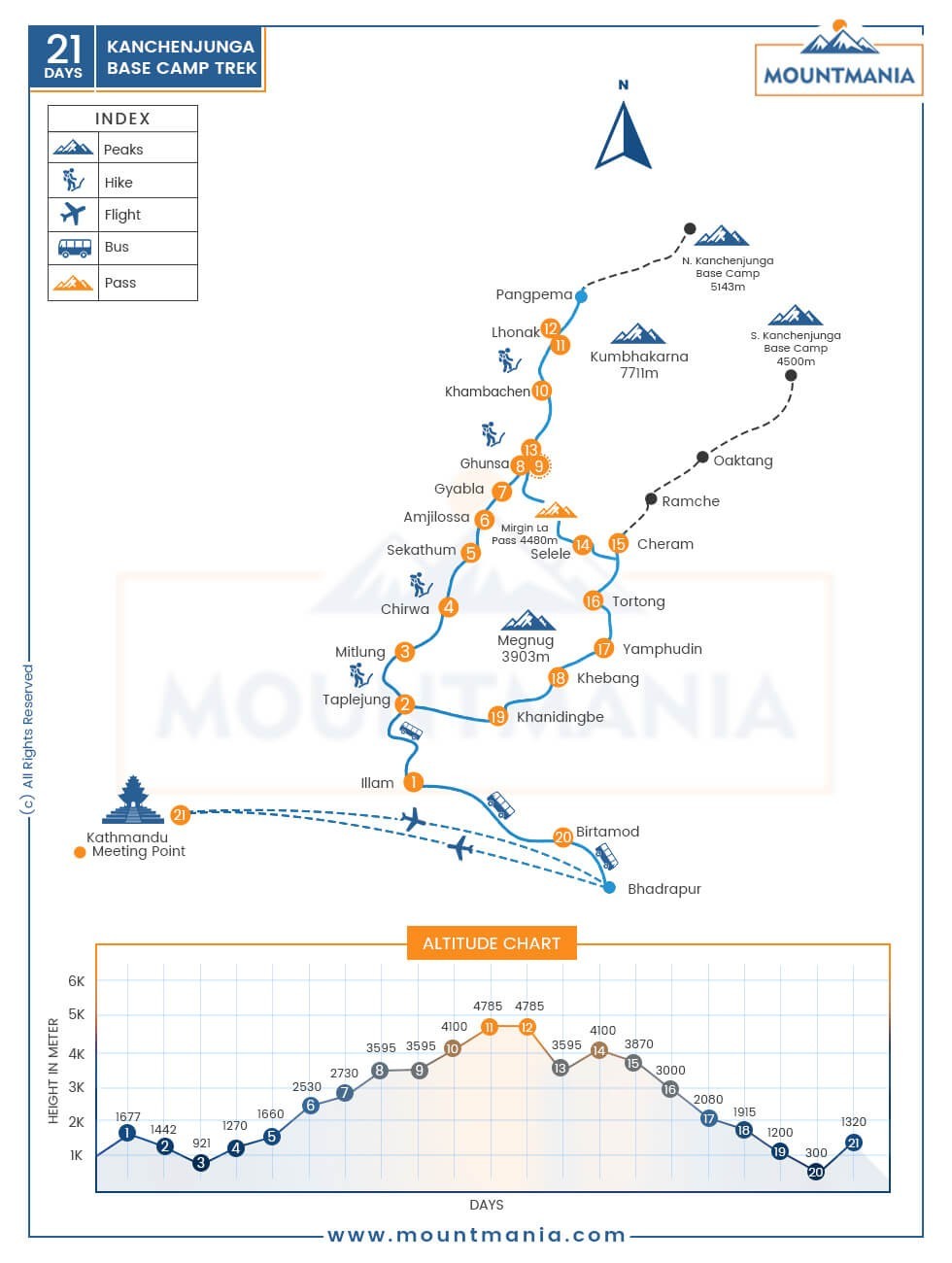
Kanchenjunga Trek Distance
The Kanchenjunga Circuit Trek is one of the longer and more demanding trekking routes in Nepal. The total distance covered during this trek varies depending on the specific itinerary and whether trekkers choose to visit both the north and south base camps or focus on one. The total Kanchenjunga Trek Distance is Approximate: 220-240 kilometers (137-149 miles)
Here are some details on the distances involved:
- Taplejung to Mitlung: Approximately 10 km
- Mitlung to Chirwa: Approximately 16 km
- Chirwa to Sekathum: Approximately 16 km
- Sekathum to Amjilosa: Approximately 12 km
- Amjilosa to Gyabla: Approximately 10 km
- Gyabla to Ghunsa: Approximately 17 km
- Ghunsa to Kambachen: Approximately 15 km
- Kambachen to Lhonak: Approximately 10 km
- Lhonak to Pangpema (North Base Camp): Approximately 10 km
- Return from Pangpema to Ghunsa: Approximately 35 km
- Ghunsa to Sele La Pass: Approximately 16 km
- Sele La Pass to Cheram: Approximately 12 km
- Cheram to Ramche (South Base Camp): Approximately 12 km
- Return from Ramche to Cheram: Approximately 12 km
- Cheram to Tortong: Approximately 20 km
- Tortong to Yamphuding: Approximately 26 km
- Yamphuding to Khebang: Approximately 17 km
- Khebang to Taplejung: Approximately 26 km
The distance can vary based on the exact route taken and the starting/ending points chosen by trekkers. Some itineraries might include additional acclimatization days and side trips, which can add extra kilometers to the trek. The trek involves significant elevation changes, from around 1,200 meters at the starting point to over 5,143 meters at the highest point, Pangpema. This makes the trek not only long in distance but also challenging in terms of altitude and terrain.
Kanchenjunga Trek Solo
While many trekking routes in Nepal offer the flexibility for independent exploration, the Kanchenjunga trek stands apart with its unique regulations. The Kanchenjunga trail requires at least two trekkers and an experienced guide, unlike other trails where solo hiking is permitted. Nevertheless, a "ghost permit" provides a workaround.
Here are some reasons why using a guide or porter is both advantageous and essential:
- Effective Planning: A knowledgeable guide takes care of the travel arrangements, such as lodging and permits, to make sure everything runs smoothly. Trekkers can now concentrate just on having a great time as a result.
- Local Knowledge: The hiking experience is enhanced by the guides' insightful explanations of the region's geography, customs, and culture.
- Physical Assistance: By relieving trekkers of some of the strain of carrying heavy equipment, porters improve the comfort and enjoyment of the hike.
- Economic Support: Hiring local porters and guides directly boosts the local economy and creates a win-win situation for all parties.
All things considered, hiring a guide goes above and beyond simply complying with regulations that mandate a minimum of two trekkers and a guide for the Kanchenjunga hike. In addition to supporting local communities, it improves convenience, safety, and cross-cultural understanding. Following advice from locals enhances the Kanchenjunga experience, whether one is walking alone or with others.
Kanchenjunga Trek Difficulty
As one of Nepal's longer, more distant, and higher-altitude treks, the Kanchenjunga Trekking difficulty level is rated as hard. It begins at Bhadrapur at 91 meters above sea level and reaches Pang Pema (North Base Camp) at 5,143 meters. As such, meteorological parameters such as humidity, air pressure, and temperature are unpredictable and unstable.
The Kanchenjunga trek is an untraversed route similarly. You must trek on rough terrain for the bulk of the trail, which is rather remote. Thus, there are days when you feel physically tired. Thus, outdoor sports like hiking, running, swimming, cycling, etc., can help you keep a healthy fitness level."
In addition, altitude sickness, often known as acute mountain sickness (AMS), can occur when trekking above 3,000 meters. Hence, pay attention to your body, walk at your speed, and drink enough of water. It is a good idea to follow your family physician's advice regarding your fitness and general health.
It doesn't take much prior trekking expertise to complete the Kanchenjunga Circuit trip, despite its high level. Anyone fit enough can do this walk given enough time and preparedness.
Best Time For Kanchenjunga Trekking
Trekking up the Kanchenjunga is best done in the spring (March to May) and fall (September to November). These months provide bright skies, moderate temperatures, and typically consistent weather, which makes them perfect for trekking and taking in the breathtaking vistas of the Kanchenjunga mountain range.
The temperature is often pleasant in the spring when the landscape is adorned with vivid hues from the blooming rhododendrons and other wildflowers. Trekkers may take in expansive vistas of the mountains throughout the fall season thanks to bright sky and good visibility.
It is important to remember that weather patterns might change, so before you plan your journey, it is a good idea to get the most recent information by contacting local guides or trekking companies. In addition, some hikers decide to go during the off-season, although there may be more erratic weather at that time.
Kanchenjunga Trek Cost
A number of variables, including the length of the journey, the route used, the services provided (such as lodging, meals, and a guide), permits, transportation, and any extra activities or equipment required, might affect the cost of hiking to Kanchenjunga.
An overview of possible costs is shown below:
- Permits: To trek in the Kanchenjunga region, you will require permits. These usually consist of the Restricted Area Permit and the Kanchenjunga Conservation Area Permit. Permit costs for foreigners and citizens may differ.
- Porter and Guide: For convenience and safety, it is advised to hire a porter and/or guide. The price will vary based on their level of experience and the length of the trek.
- Lodging: Teahouses and camping are just two of the lodging possibilities. While camping may need extra equipment and fees, teahouse prices are usually fair.
- Meals: The majority of trek packages include meals. Otherwise, you'll have to factor in meals while hiking.
- Travel: The cost of transportation to and from the trek's beginning point may increase the overall cost. Air travel and ground transportation are included in this.
- Equipment: If you don't own the necessary hiking gear, you might have to buy or rent items like sleeping bags, coats, and trekking poles.
Miscellaneous: You may also need to pay for travel insurance, gratuities, extra activities, and mementos.
In general, depending on your choice of services and degree of luxury, you should plan to spend at least $3,000 per person for a 15 to 20-day hike to Mount Kanchenjunga. For a more seamless trip, it is advised to do extensive research and think about making your reservation through a reliable trekking organization.
Kanchenjunga Base Camp Height
At approximately 5,130 meters (16,830 feet) above sea level, the Kanchenjunga Base Camp is the highest point of the climb. Beautiful views of the spectacular Himalayan peaks, including Kanchenjunga, the third-highest mountain in the world, may be seen from this base camp. The journey takes about 18 to 20 days to finish and passes through pristine alpine forests, steep mountain passes, and traditional Sherpa settlements. It also typically goes through remote and harsh terrain.
Kanchenjunga Trek Permit
You will require both a trekking permit and a restricted area permit to trek in Nepal's Kanchenjunga region, as the area is off-limits to visitors. An outline is provided here:
Trekking permission: In Nepal, trekking permission can be obtained from the Department of Immigration in Kathmandu or Pokhara, or a certified trekking agency. Depending on the time of year and the length of your trek, different fees apply for trekking permits. Along with filling out the required papers, you'll need to bring your passport and two passport-sized pictures.
Restricted Area Permit: You will also require a special permit because the Kanchenjunga region is a restricted area. You will need to submit your trekking itinerary and other necessary documentation to receive this permit, which can be obtained through a certified trekking agency. Compared to a regular trekking permit, a restricted region permit costs more.
You must trek in Nepal through an authorized trekking organization since they will take care of all the paperwork and logistics. In addition, you will receive a guide, which is necessary for trekking in forbidden regions like Kanchenjunga. As laws and specifications are subject to change, be careful to verify the most recent versions before organizing your hike.
The most popular off-beaten high-altitude trek in Nepal is the Kanchenjunga Trek. There are some of the best mountain views in the area and a rewarding journey to both of Mt. Kanchenjunga's base camps. Arrange this trip if you're looking to push yourself.
Conclusion
The Kanchenjunga Base Camp Trek offers a blend of rustic teahouse stays and the possibility of camping in more remote sections. Meals are generally hearty and designed to keep trekkers energized, but the variety decreases with altitude. Proper planning and preparation can ensure a comfortable and nourishing experience throughout the trek

.png)
